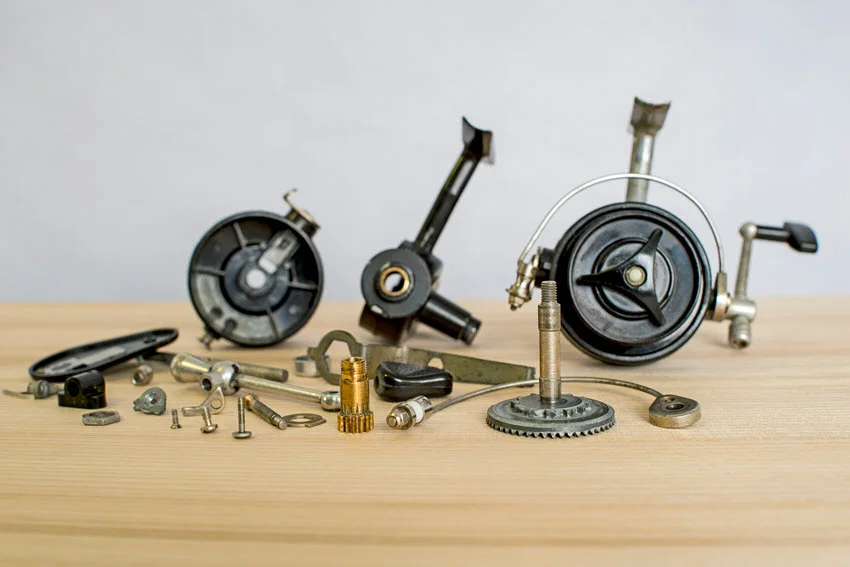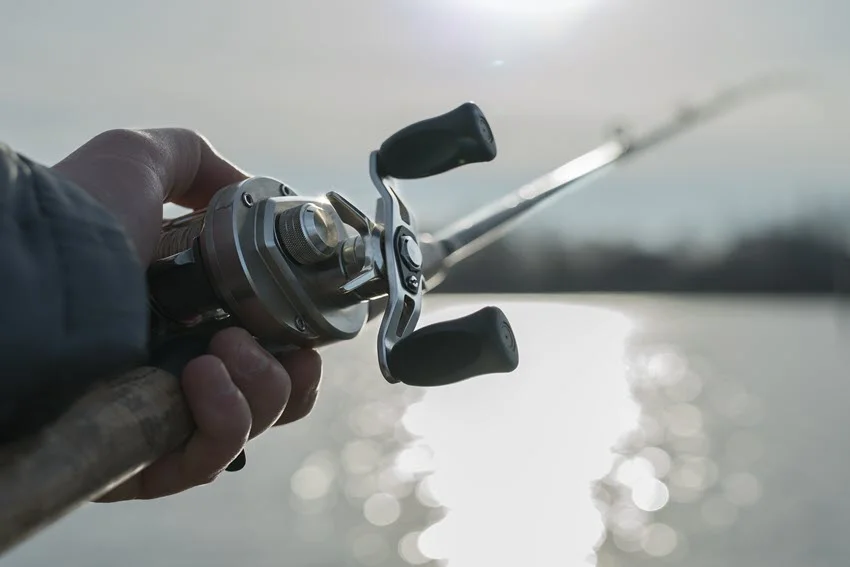Anglers Booking Team
The expert copywriters at Anglers Booking have meticulously crafted this article. Our dedicated team of writers provides valuable insights and information to enhance your angling experience.
 9 minutes read
9 minutes readKnowing which rod suits you the most isn’t enough. There is no rod without a reel, so basic knowledge of fishing reels is required.
The following article explains in detail what each reel’s performance is made for. In the beginning, you’ll get to know the main components of the reel and get closer to understanding the purpose of a fishing reel.

Then, you will read what types of reels are available and what the specifications and features of each reel are. With all that information, deciding what type of reel to use should be easy.
A fishing reel is a complex engineering construction made of a few parts that couldn’t do much if they were separate, but built in one, they make a perfect combination with whom fishing wouldn’t be possible. Understanding the fishing reel parts before starting to use them is crucial.

Each reel is constructed of the following parts:
Reel Body: This is one of the main elements of the reel. It is mainly made of aluminum or graphite. The difference is strength, as aluminum is stronger and heavier, unlike graphite, which is more lightweight but a better option for saltwater.
Handle: The handle is a tool for retrieving the line after you cast it. It can be right or left-sided, depending on whether you are left or right-handed.
Gears: These are designed to convert power from the handle to the spool. When you turn the handle, the gears become involved by fighting or luring a fish. The gears typically come with a ratio scale that indicates how fast the line retrieves after casting. The gear ratio signifies the interaction between the number of upheavals made by the spool and the handle in one turn. The high ratio is typically 7.1:1 or higher, the low ratio is 5.4:1 or lower, and the medium ratio is around 6.1:1 – 6.4:1. The higher the gear ratio, the faster the line retrieves. More excellent gear ratios are significant for challenging water conditions when dealing with large fish that move fast. Lower gears make dealing with heavy fish easier because they have more power.
Spool: The function of the spool is to hold the line and provide the casting distance and control of the operation. The spool is cylindrical, and it is, like a reel body, mostly made of aluminum or graphite.
Drag System: The primary purpose of drag is to prevent the line from fracturing and to add pressure that the fish has to overcome to get out of the line. A lever drug system or a star drag system typically directs the drug system. Every drag system has a drag knob that helps you optimize the amount of resistance that is applied.
Now that you know the main fishing reel parts, let’s explore the essential types.

Baitcasting reels are positioned on top of the rod. One of the most critical features of the reel is that it rotates as the line releases, which prevents twisting. You must control the reel with your thumb to do this successfully, putting it directly on the reel spool.
First, you create tension with the thumb and cast, then you remove the thumb before the bait hits the water, and when it does, you return the thumb. However, this is not for beginner fishing setup as it is not easy to maneuver, so if you want to choose these reels for your beginning, you will need practice to manage them.
Baitcasting reels are designed to provide far castings and fast extracting and retrieving casts with great accuracy.
They are great for all lines and lures because of their complex construction, which provides excellent control systems and balance. The most common line types used for baitcasting reels are braid, nylon, monofilament, and fluorocarbon. However, the best has been braid because the braided line is typically stronger than monofilament and fluorocarbon, allowing smoother flows off a fishing reel.
What makes these reels among the most popular is a combination of high-quality drag system, spool tension knob, and braking system. Drag controls the energy needed to start the spinning spool while the reel is engaged.
The spool tension knob determines how much power is required to start the spool after you disengage the reel by pressing the thumb. The braking system improves the casting by slowing the spool at the end of the cast to prevent unexpected tangles.

This reel is easy to use and ideal for beginners due to its simple construction and guiding style. The spool is fixed to the rod with a single button that releases the line when pressed. The spool is a closed type with a line beneath, and it doesn't rotate but unwinds as far as you allow. The line rarely tangles since it is placed in a spool that is mainly made of plastic.
Although it cannot be seen, it can be easily controlled by pressing a button. When you want to release the line, press the button. When you want it to stop, release it. It is simple to operate, so it is often a choice for children or inexperienced anglers. Spincast reels are affordable, usually the cheapest type on the market, which makes this reel a good combination of affordability and practicality.
On the negative side, these reels are often smaller than others, offering a small cast. The most popular area where you can use these reels is freshwater, where you can target smaller fish. You will not see these reels often in saltwater, as they can’t handle heavy saltwater fish species.
In summary, this reel type is the perfect choice for starting your fishing career or hobby when you want to enjoy your time on the water without much effort.

Experienced anglers and beginners choose this reel because it is suitable for all types of fishing. It offers reasonable control, durability, and precision; it's no wonder it’s one of the most popular reels on the market.
Spinning reels are a good choice for most fishing techniques and styles. Therefore, they can be used for lightweight jigs, heavy lures, and fishing species ranging from Panfish to Muskies. The weights they can handle depend on size, ranging from ultra-light to extra-heavy models.
A spinning reel is not easy to use, so if you are a first-time user, it could be challenging to manage, but it is possible with practice.
The spinning reel is constructed from the spool, handle, drag knob, reel foot, and, unlike other reels, bail arm and line rollers.
The spool is an open type that is fixed underneath the rod. The line over the spool shows how much it unwinds when you cast the lure. You use a handle to maneuver the reel and control releasing or returning the line. A bail arm is a metal arm that you can keep open or closed depending on whether you want to release the line from the spool.
The reel foot is constructed to hold the rod and reel together. The drag knob controls the ability of the line to come out of the spool when the bail is closed. When the knob is tightened, the line cannot come out, but if it is relaxed, the line can come out with a bit of effort. The line roller keeps the spool fixed to the rod.
This reel offers versatility, efficiency, and good casting control, making your fishing experience comfortable.

A fly reel is also popular due to its strength and high tolerances, making it ideal for fly fishing with great castings.
It comprises two drag systems: a disc or click and a pawl. The Dysk system prevents fish from running out of line, and the click and pawl systems are made to avoid tangling. This reel is made of one of three retrieval systems – single action, multiplying, and automatic.
Single action is used chiefly because its retrieval ratio is 1:1, so one complete spool rotation is the same as a whole handle turn. Multiplying is less common than a single action, and its retrieval ratio is more significant than 1:1. Automatic reels mean automatic line retrieval without turning the handle.
A fly reel is positioned at the bottom of the rod with a large spool and release and a handle on the side. This reel is used primarily in freshwater, like rivers, ponds, or lakes, but it is also seen in saltwater, where anglers target larger fish species. The catch combines large and heavy main lines with lightweight leader lines, providing a well-balanced fishing system. With this combination, you can handle heavy fish with even the slightest lure.
Once you figure out how it works, a fly reel offers excellent accuracy and control. Another great benefit is its durability. Once you buy it, you can use it for years. The negative side of this reel is that it can only be used for fly fishing and is relatively expensive. Besides that, it is not a great choice for novice beginners, as it requires more practice to manage handling.
We went through the basic information about fishing reels, and we hope we have helped you make your choice easier. Since there are different reel models for various purposes and specific fishing situations, it is clear that it can take some time to make decisions.
However, each reel is suitable for a particular occasion and can be used, so you can’t make a great mistake. This article shows the necessary differences in detail to make the best decision. Good luck!
What types of fishing reels do you prefer, and how do you use them? Share your experiences in the comments section below!

The expert copywriters at Anglers Booking have meticulously crafted this article. Our dedicated team of writers provides valuable insights and information to enhance your angling experience.
Embark on unforgettable fishing adventures with us at Anglers Booking.
book your charterOctober 17, 2025
October 15, 2025
October 10, 2025
October 11, 2025
October 4, 2025
September 29, 2025
September 25, 2025
September 21, 2025

You're now part of our exclusive community. Get ready for premium content and updates straight to your inbox.
close
Subscribe to our newsletter and receive a selection of cool articles every week.
Please enter a valid email address.

Be the first to know when we're back in action.
Please enter a valid email address.
Leave a Comment
Your email address will not be published. Required fields are marked *
Thank you for your comment! It has been submitted for review and will appear on the site shortly.